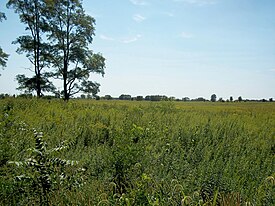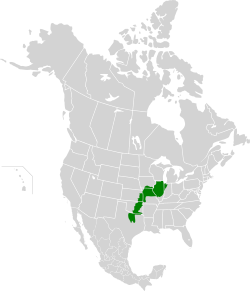Central forest–grasslands transition
| Central forest–grasslands transition | |
|---|---|
 | |
 | |
| Ecology | |
| Realm | Nearctic |
| Biome | Temperate grasslands, savannas, and shrublands |
| Borders | List
|
| Bird species | 234 Humid continental (Dfa) and humid subtropical (Cfa) |
| Conservation | |
| Habitat loss | 67.6%[1] |
| Protected | 2.09%[1] |
The central forest–grasslands transition is a
World Wildlife Fund
.
Setting
This is a large area covering 407,000 square kilometres (157,000 sq mi) from northern
Central and Southern mixed grasslands and Central tall grasslands to the west.[2]
Fauna
This ecoregion is rich in reptiles, birds and insects. Birds of the area include the
greater prairie chicken. Reptiles include the Osage copperhead snake
.
Threats and preservation
The area has almost entirely been converted to agriculture, particularly planting corn and soybeans. Remaining blocks of intact habitat are small and include the
See also
References
- ^ a b c d
Hoekstra, J. M.; Molnar, J. L.; Jennings, M.; Revenga, C.; Spalding, M. D.; Boucher, T. M.; Robertson, J. C.; Heibel, T. J.; Ellison, K. (2010). Molnar, J. L. (ed.). The Atlas of Global Conservation: Changes, Challenges, and Opportunities to Make a Difference. ISBN 978-0-520-26256-0.
- ^ "Central forest-grasslands transition". Terrestrial Ecoregions. World Wildlife Fund.
- ^ [Chicago Wilderness Magazine, Summer 2000 http://www.chicagowildernessmag.org/issues/summer2000/gensburg.html]
External links
- Central forest-grasslands transition, Encyclopedia of Earth
